Jie Xiao
refer to the report for detailed contributions
Latent Harmony: Synergistic Unified UHD Image Restoration via Latent Space Regularization and Controllable Refinement
Oct 09, 2025



Abstract:Ultra-High Definition (UHD) image restoration faces a trade-off between computational efficiency and high-frequency detail retention. While Variational Autoencoders (VAEs) improve efficiency via latent-space processing, their Gaussian constraint often discards degradation-specific high-frequency information, hurting reconstruction fidelity. To overcome this, we propose Latent Harmony, a two-stage framework that redefines VAEs for UHD restoration by jointly regularizing the latent space and enforcing high-frequency-aware reconstruction.In Stage One, we introduce LH-VAE, which enhances semantic robustness through visual semantic constraints and progressive degradation perturbations, while latent equivariance strengthens high-frequency reconstruction.Stage Two jointly trains this refined VAE with a restoration model using High-Frequency Low-Rank Adaptation (HF-LoRA): an encoder LoRA guided by a fidelity-oriented high-frequency alignment loss to recover authentic details, and a decoder LoRA driven by a perception-oriented loss to synthesize realistic textures. Both LoRA modules are trained via alternating optimization with selective gradient propagation to preserve the pretrained latent structure.At inference, a tunable parameter {\alpha} enables flexible fidelity-perception trade-offs.Experiments show Latent Harmony achieves state-of-the-art performance across UHD and standard-resolution tasks, effectively balancing efficiency, perceptual quality, and reconstruction accuracy.
Group Critical-token Policy Optimization for Autoregressive Image Generation
Sep 26, 2025Abstract:Recent studies have extended Reinforcement Learning with Verifiable Rewards (RLVR) to autoregressive (AR) visual generation and achieved promising progress. However, existing methods typically apply uniform optimization across all image tokens, while the varying contributions of different image tokens for RLVR's training remain unexplored. In fact, the key obstacle lies in how to identify more critical image tokens during AR generation and implement effective token-wise optimization for them. To tackle this challenge, we propose $\textbf{G}$roup $\textbf{C}$ritical-token $\textbf{P}$olicy $\textbf{O}$ptimization ($\textbf{GCPO}$), which facilitates effective policy optimization on critical tokens. We identify the critical tokens in RLVR-based AR generation from three perspectives, specifically: $\textbf{(1)}$ Causal dependency: early tokens fundamentally determine the later tokens and final image effect due to unidirectional dependency; $\textbf{(2)}$ Entropy-induced spatial structure: tokens with high entropy gradients correspond to image structure and bridges distinct visual regions; $\textbf{(3)}$ RLVR-focused token diversity: tokens with low visual similarity across a group of sampled images contribute to richer token-level diversity. For these identified critical tokens, we further introduce a dynamic token-wise advantage weight to encourage exploration, based on confidence divergence between the policy model and reference model. By leveraging 30\% of the image tokens, GCPO achieves better performance than GRPO with full tokens. Extensive experiments on multiple text-to-image benchmarks for both AR models and unified multimodal models demonstrate the effectiveness of GCPO for AR visual generation.
Hunyuan3D Studio: End-to-End AI Pipeline for Game-Ready 3D Asset Generation
Sep 16, 2025



Abstract:The creation of high-quality 3D assets, a cornerstone of modern game development, has long been characterized by labor-intensive and specialized workflows. This paper presents Hunyuan3D Studio, an end-to-end AI-powered content creation platform designed to revolutionize the game production pipeline by automating and streamlining the generation of game-ready 3D assets. At its core, Hunyuan3D Studio integrates a suite of advanced neural modules (such as Part-level 3D Generation, Polygon Generation, Semantic UV, etc.) into a cohesive and user-friendly system. This unified framework allows for the rapid transformation of a single concept image or textual description into a fully-realized, production-quality 3D model complete with optimized geometry and high-fidelity PBR textures. We demonstrate that assets generated by Hunyuan3D Studio are not only visually compelling but also adhere to the stringent technical requirements of contemporary game engines, significantly reducing iteration time and lowering the barrier to entry for 3D content creation. By providing a seamless bridge from creative intent to technical asset, Hunyuan3D Studio represents a significant leap forward for AI-assisted workflows in game development and interactive media.
Echo: Decoupling Inference and Training for Large-Scale RL Alignment on Heterogeneous Swarms
Aug 07, 2025Abstract:Modern RL-based post-training for large language models (LLMs) co-locate trajectory sampling and policy optimisation on the same GPU cluster, forcing the system to switch between inference and training workloads. This serial context switching violates the single-program-multiple-data (SPMD) assumption underlying today's distributed training systems. We present Echo, the RL system that cleanly decouples these two phases across heterogeneous "inference" and "training" swarms while preserving statistical efficiency. Echo introduces two lightweight synchronization protocols: a sequential pull mode that refreshes sampler weights on every API call for minimal bias, and an asynchronous push-pull mode that streams version-tagged rollouts through a replay buffer to maximise hardware utilisation. Training three representative RL workloads with Qwen3-4B, Qwen2.5-7B and Qwen3-32B on a geographically distributed cluster, Echo matches a fully co-located Verl baseline in convergence speed and final reward while off-loading trajectory generation to commodity edge hardware. These promising results demonstrate that large-scale RL for LLMs could achieve datacentre-grade performance using decentralised, heterogeneous resources.
HunyuanWorld 1.0: Generating Immersive, Explorable, and Interactive 3D Worlds from Words or Pixels
Jul 29, 2025Abstract:Creating immersive and playable 3D worlds from texts or images remains a fundamental challenge in computer vision and graphics. Existing world generation approaches typically fall into two categories: video-based methods that offer rich diversity but lack 3D consistency and rendering efficiency, and 3D-based methods that provide geometric consistency but struggle with limited training data and memory-inefficient representations. To address these limitations, we present HunyuanWorld 1.0, a novel framework that combines the best of both worlds for generating immersive, explorable, and interactive 3D scenes from text and image conditions. Our approach features three key advantages: 1) 360{\deg} immersive experiences via panoramic world proxies; 2) mesh export capabilities for seamless compatibility with existing computer graphics pipelines; 3) disentangled object representations for augmented interactivity. The core of our framework is a semantically layered 3D mesh representation that leverages panoramic images as 360{\deg} world proxies for semantic-aware world decomposition and reconstruction, enabling the generation of diverse 3D worlds. Extensive experiments demonstrate that our method achieves state-of-the-art performance in generating coherent, explorable, and interactive 3D worlds while enabling versatile applications in virtual reality, physical simulation, game development, and interactive content creation.
Thought Purity: Defense Paradigm For Chain-of-Thought Attack
Jul 16, 2025Abstract:While reinforcement learning-trained Large Reasoning Models (LRMs, e.g., Deepseek-R1) demonstrate advanced reasoning capabilities in the evolving Large Language Models (LLMs) domain, their susceptibility to security threats remains a critical vulnerability. This weakness is particularly evident in Chain-of-Thought (CoT) generation processes, where adversarial methods like backdoor prompt attacks can systematically subvert the model's core reasoning mechanisms. The emerging Chain-of-Thought Attack (CoTA) reveals this vulnerability through exploiting prompt controllability, simultaneously degrading both CoT safety and task performance with low-cost interventions. To address this compounded security-performance vulnerability, we propose Thought Purity (TP): a defense paradigm that systematically strengthens resistance to malicious content while preserving operational efficacy. Our solution achieves this through three synergistic components: (1) a safety-optimized data processing pipeline (2) reinforcement learning-enhanced rule constraints (3) adaptive monitoring metrics. Our approach establishes the first comprehensive defense mechanism against CoTA vulnerabilities in reinforcement learning-aligned reasoning systems, significantly advancing the security-functionality equilibrium for next-generation AI architectures.
NTIRE 2025 Image Shadow Removal Challenge Report
Jun 18, 2025Abstract:This work examines the findings of the NTIRE 2025 Shadow Removal Challenge. A total of 306 participants have registered, with 17 teams successfully submitting their solutions during the final evaluation phase. Following the last two editions, this challenge had two evaluation tracks: one focusing on reconstruction fidelity and the other on visual perception through a user study. Both tracks were evaluated with images from the WSRD+ dataset, simulating interactions between self- and cast-shadows with a large number of diverse objects, textures, and materials.
FreePCA: Integrating Consistency Information across Long-short Frames in Training-free Long Video Generation via Principal Component Analysis
May 02, 2025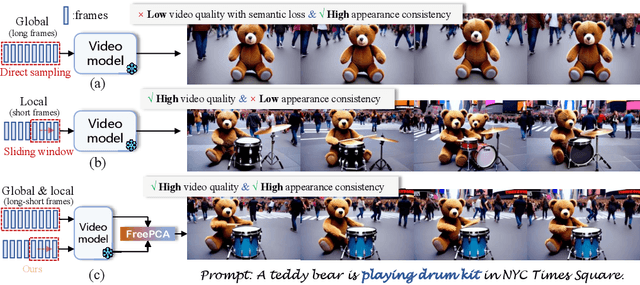
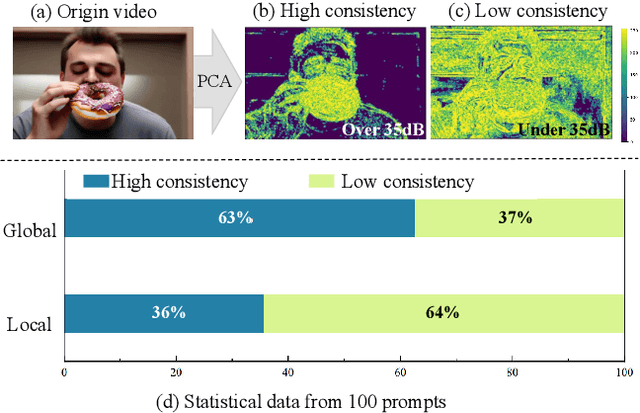
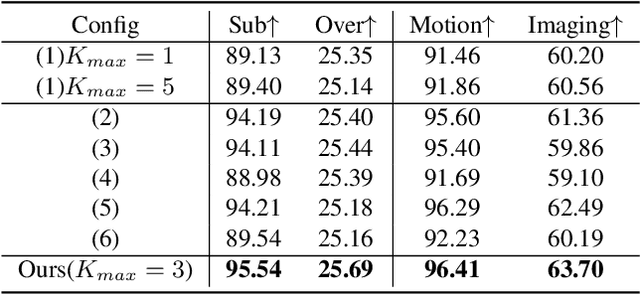
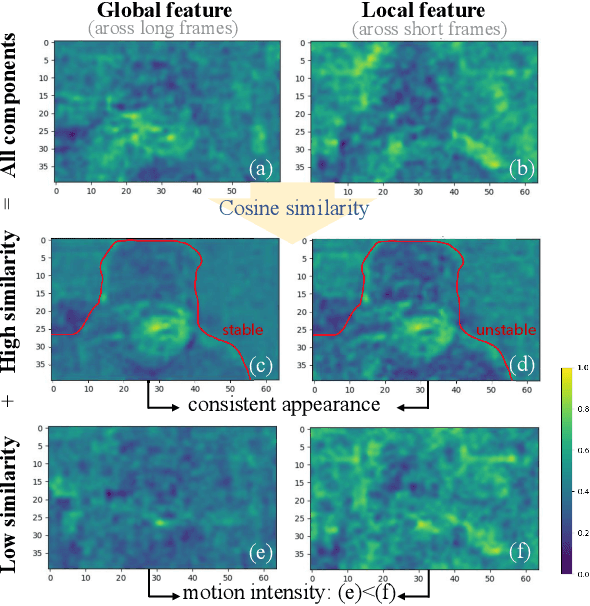
Abstract:Long video generation involves generating extended videos using models trained on short videos, suffering from distribution shifts due to varying frame counts. It necessitates the use of local information from the original short frames to enhance visual and motion quality, and global information from the entire long frames to ensure appearance consistency. Existing training-free methods struggle to effectively integrate the benefits of both, as appearance and motion in videos are closely coupled, leading to motion inconsistency and visual quality. In this paper, we reveal that global and local information can be precisely decoupled into consistent appearance and motion intensity information by applying Principal Component Analysis (PCA), allowing for refined complementary integration of global consistency and local quality. With this insight, we propose FreePCA, a training-free long video generation paradigm based on PCA that simultaneously achieves high consistency and quality. Concretely, we decouple consistent appearance and motion intensity features by measuring cosine similarity in the principal component space. Critically, we progressively integrate these features to preserve original quality and ensure smooth transitions, while further enhancing consistency by reusing the mean statistics of the initial noise. Experiments demonstrate that FreePCA can be applied to various video diffusion models without requiring training, leading to substantial improvements. Code is available at https://github.com/JosephTiTan/FreePCA.
Exposure Bias Reduction for Enhancing Diffusion Transformer Feature Caching
Mar 10, 2025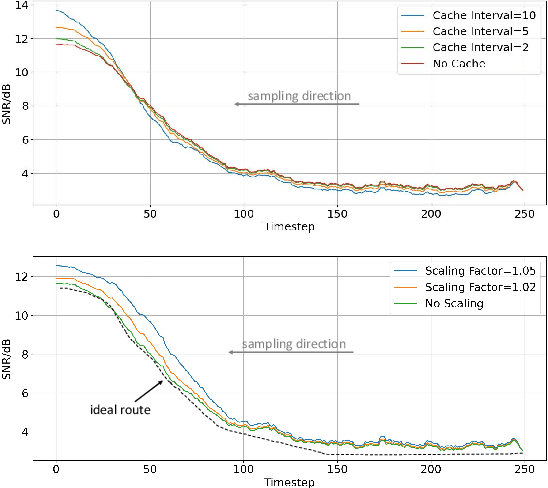
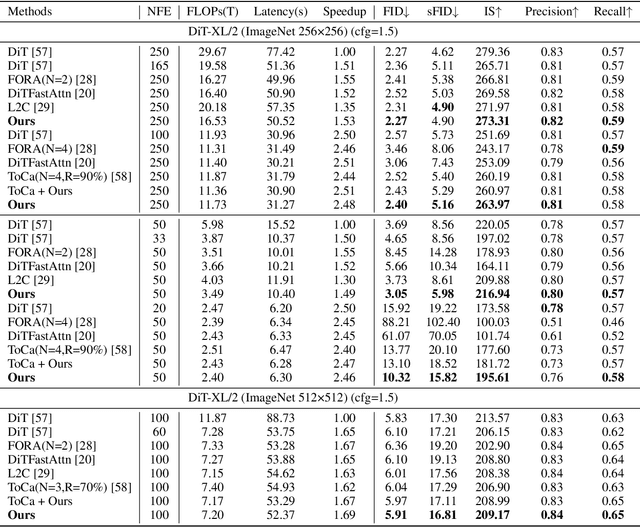


Abstract:Diffusion Transformer (DiT) has exhibited impressive generation capabilities but faces great challenges due to its high computational complexity. To address this problem, various methods, notably feature caching, have been introduced. However, these approaches focus on aligning non-cache diffusion without analyzing the impact of caching on the generation of intermediate processes. So the lack of exploration provides us with room for analysis and improvement. In this paper, we analyze the impact of caching on the SNR of the diffusion process and discern that feature caching intensifies the denoising procedure, and we further identify this as a more severe exposure bias issue. Drawing on this insight, we introduce EB-Cache, a joint cache strategy that aligns the Non-exposure bias (which gives us a higher performance ceiling) diffusion process. Our approach incorporates a comprehensive understanding of caching mechanisms and offers a novel perspective on leveraging caches to expedite diffusion processes. Empirical results indicate that EB-Cache optimizes model performance while concurrently facilitating acceleration. Specifically, in the 50-step generation process, EB-Cache achieves 1.49$\times$ acceleration with 0.63 FID reduction from 3.69, surpassing prior acceleration methods. Code will be available at \href{https://github.com/aSleepyTree/EB-Cache}{https://github.com/aSleepyTree/EB-Cache}.
Hunyuan3D 2.0: Scaling Diffusion Models for High Resolution Textured 3D Assets Generation
Jan 21, 2025



Abstract:We present Hunyuan3D 2.0, an advanced large-scale 3D synthesis system for generating high-resolution textured 3D assets. This system includes two foundation components: a large-scale shape generation model -- Hunyuan3D-DiT, and a large-scale texture synthesis model -- Hunyuan3D-Paint. The shape generative model, built on a scalable flow-based diffusion transformer, aims to create geometry that properly aligns with a given condition image, laying a solid foundation for downstream applications. The texture synthesis model, benefiting from strong geometric and diffusion priors, produces high-resolution and vibrant texture maps for either generated or hand-crafted meshes. Furthermore, we build Hunyuan3D-Studio -- a versatile, user-friendly production platform that simplifies the re-creation process of 3D assets. It allows both professional and amateur users to manipulate or even animate their meshes efficiently. We systematically evaluate our models, showing that Hunyuan3D 2.0 outperforms previous state-of-the-art models, including the open-source models and closed-source models in geometry details, condition alignment, texture quality, and etc. Hunyuan3D 2.0 is publicly released in order to fill the gaps in the open-source 3D community for large-scale foundation generative models. The code and pre-trained weights of our models are available at: https://github.com/Tencent/Hunyuan3D-2
 Add to Chrome
Add to Chrome Add to Firefox
Add to Firefox Add to Edge
Add to Edge